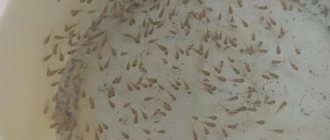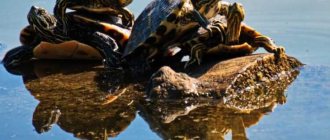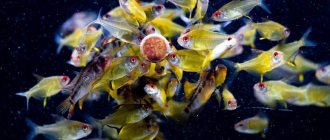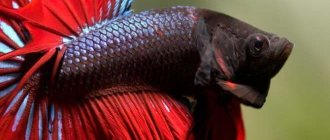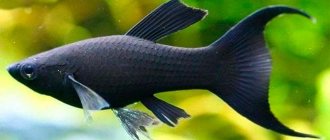Beginning aquarists often find themselves in the dark, not knowing exactly what kind of fish to get. Seeing a small and cute pterygoplicht in a pet store, they don’t even realize that it can grow more than 30 cm and live more than 20 years.
But this graceful astronotus will grow very large and will gladly eat everything that fits in its mouth. So which fish are best to avoid at first? This article contains 15 of the most common but difficult to keep aquarium fish.
Below I will list 15 species (and here you can find the 10 best fish for beginners, or the top 10 unusual aquarium fish) that are very popular, but at the same time very difficult to keep.
If you are a beginner aquarist, you may want to avoid these fish, at least until you gain experience. Then you can create the necessary conditions in a common aquarium or start a separate aquarium for these fish.
Definitely, each of the fish listed below is not the easiest to keep and requires much more care than an ordinary fish.
As a rule, they need special water parameters, or powerful filtration, or they are aggressive, or they like to destroy everything in the aquarium, and most often these fish are simply huge and require very large aquariums.
So let's get started.
Black pacu
This is a herbivorous relative of the well-known piranha. They belong to the same genus - Characidae. But what distinguishes the black pacu from the piranha is the size of the fish when it becomes sexually mature.
And here newbies face problems. Most pacu that you can see for sale will be no more than 5-7 cm in length, with beautiful colors and peaceful behavior. However, these fish will outgrow a 200 liter aquarium in the first year of their life and will continue to grow, often reaching a weight of 4 kg and a body length of 40 cm.
And their colors will fade. Unless you have a ton-sized aquarium at home, avoid these fish at all costs. Like all the others, about which the seller speaks very vaguely when you ask about its sizes.
Lifespan of a glass container
Among contemplators of large-volume containers, different thoughts often pop up, one of which is: “What will happen if this colossus bursts?” Of course, the fears of aquarists are not in vain - leakage of large aquariums is a disaster, due to which you can get to know your neighbors several floors below. Some owners of particularly large volumes even take out insurance in case of accidents.
How long a particular aquarium will last depends primarily on the quality of its assembly and the materials used. It is believed that branded aquariums are more reliable than those made by craftsmen.
Many silicone manufacturers claim a service life of 25 years. This means that, in theory, an aquarium made with high-quality silicone can last you over 20 years. The lifespan of glass is unlimited, and with proper use this material can last as long as you like.
Of course, the real life span of aquariums is far from those described above. Very often we do not notice various minor gluing defects, we place the container on the wrong surface or simply care for it incorrectly, which significantly reduces its service life.
Here are a few rules that will help prolong the integrity of the glass container:
- Do not buy bulk aquariums from untrustworthy manufacturers.
- Be sure to inspect the seams before purchasing. There should be no bubbles in them, and the silicone itself should not move away from the glass. Its layer should be thick and uniform.
- A large aquarium should be equipped with a frame and stiffeners.
- Black silicone is considered more durable than transparent silicone due to ballast additives.
- Before putting the container into operation, fill it with water and watch the seams - they should not become wet.
- The larger the aquarium, the thicker its glass should be.
- When cleaning the walls of the aquarium from algae, calcium and biological fouling, it is strictly not recommended to use a blade, because one awkward movement and the silicone seam will be ripped apart. To clean your home pond, it is better to use soft sponges or magnetic scrapers.
- Do not wipe the aquarium with chemicals that can corrode the seam.
- It is advisable to place the aquarium on a special stand that can constantly withstand heavy weight. Before doing this, you need to thoroughly wipe the surface, and then put a foam rubber or foam backing on it that can absorb all the unevenness.
- Owners of large tanks are advised to check the seams every 5-7 years, and if a restart is planned, it would be wise to replace the silicone in the aquarium.
- Periodically inspect the cabinet on which the aquarium sits. Leaking filters, drops of condensation and other factors can cause the tree to crumble or swell. Such a stand is not reliable and causes concern.
- It is better to place the aquarium in a place with the least traffic. After all, then the likelihood that someone will push or knock it over will be significantly reduced.
In general, the aquarium must be carefully monitored, and at the slightest suspicion of a leak, you need to check the seams and plan the temporary relocation of the inhabitants of the home pond.
In good conditions, an aquarium can last you quite a long time. Some aquarists report tanks lasting over 20 years.
Labeo bicolor and labeo green
Labeo bicolor is very popular among aquarists due to its beautiful and bright color and body shape, reminiscent of a shark. It is on this list not so much due to its complexity in content, but due to its very high territoriality.
Labeo does not tolerate any other fish that is similar in color to it, and certainly does not tolerate related species.
If you choose a labeo, then you need to keep it with large species that are different in color, otherwise it will chase and beat the fish. Plus, he grows quite large and his attacks can cause serious injuries.
Hornwort
Mentions of hornwort can be found, perhaps, on any aquarium forum, and in almost every article about starting an aquarium. This plant is considered a weed and its distribution is prohibited. And it’s not surprising - hornwort is able to fill a small reservoir in a short time.
Hornwort is a floating plant that does not have a full root system. Only aerial roots can appear on the stem. It is not used for design, fish and turtles do not eat it - the leaves are too hard. The plant is most often used for launching and left to float on the surface - the fry hide in the floating plants, and thanks to them the fish do not jump out of the aquarium.
Pterygoplicht brocade
Do you have algae problems? Get a Pterygoplichthus. It is easier to have this fish than to understand what is wrong in the aquarium. They are quite often found on sale, and buying is not a problem. But again, in the store they will be no more than 7-10 cm in length.
But he will grow up. It will grow a lot. It will grow a lot.
Most beginners start with an aquarium up to 100 liters. Buying a pterygoplicht into it is like throwing a killer whale into a pool. They grow up to 30 cm or more. You can guess how much space they require and how much waste they produce.
How to choose?
There are no specific rules that should be followed when purchasing astronotuses. The main thing is the sincere desire and preparedness of the future owner. A few simple steps will help you become more confident in your choice:
- Read about the biological characteristics of astronotus in advance. This way you will know what kind of aquarium you will need, how time-consuming and expensive it will be to keep a pet.
- Think about others. If you already have an aquarium or are planning to purchase several species at once, be sure to find out about the compatibility of astronotuses with other fish, mollusks, and crustaceans. Few people can harm a huge fish, but a predator can do harm to its neighbors.
- Please note that the astronotus fish is a long-liver. If aquarium keeping is not a temporary hobby for you and you can take care of a large fish for 10-15 years, only then this option is for you.
- Be careful about the appearance and behavior of the fish when purchasing. As mentioned above, painted astronotuses are the result of painful and harmful injections. You need to know about this in advance so as not to accidentally support a cruel business. The balloon received its unusual shape due to selective deformation, which, of course, will affect the health of the fish and its care. If in front of you is an inactive fry: it swims sluggishly and sticks to the surface, then it may be weak from birth or sick.
- The quantity depends on the intentions. If you are an experienced aquarist and plan to breed astronotuses, it is better to take 4-8 individuals at once so that the juveniles can find a pair for themselves (in the future the pairs will have to be seated, since the volumes required even for one individual are significant). In other cases, it is better to start with 1-2 fish - this is also due to the requirements for the parameters of the aquarium.
- Focus on the size of the juveniles. Ideally, you need to take fish 5-6 cm: for smaller ones, their health status and congenital disorders are not always clear. In addition, more “adult” children adapt better to new conditions.
Astronotus
Another fish that can very often be found on sale. Astronotus is often sold, which has a beautiful black and orange color and attracts attention. Astronotus needs an aquarium from 200 liters, and as it grows, from 300 to 500 liters.
This is clearly not the fish that people dream of buying first. In addition, Astronotus will eat literally any fish that fits into its mouth, and is even fed goldfish and other small species.
For beginners it is too huge and too aggressive. To keep astronotuses, you need a separate large aquarium where only large species are kept. But if you want one big, noticeable, beautiful fish with intelligence…. then this is a very good choice. Just remember to place it in a spacious aquarium.
Myth 4: Goldfish are inexpensive and easy to replace.
Goldfish are one of the most common aquarium fish species, and most of the most common types are relatively inexpensive and easily available. So many owners have this attitude: if my fish dies, I can easily replace it with a new one. However, if this species is provided with the proper conditions and care, it can turn into a magnificent aquarium fish whose owner can be proud of it. Fancy goldfish can be worth much more than many tropical fish.
Choosing the right aquarium for goldfish
So, we figured out that for goldfish you need to choose the right rectangular aquarium of the right size that can meet their needs. If you want to keep only one goldfish, then a 75-liter aquarium will be enough. But if you want more than one individual, then you need at least an additional 30-40 liters so that you can keep adult fish. Many people are simply horrified by the fact that goldfish need to have a 200-liter aquarium, but this volume is only the minimum volume for 3-4 individuals! If you want to see this species in all its glory, to fully realize its potential, you must acquire an aquarium of at least 330 liters. Remember that these fish grow very large and they produce a lot of waste, so they need a lot of water. Goldfish live 20 years or longer and will soon become your favorite pets, so make sure to give them some space and a spacious aquarium.
Ensure proper filtration in your aquarium
Most people don't think about what kind of filter they have in their goldfish aquarium, and some don't even know that their aquarium needs a filter. Filtration in a goldfish aquarium is necessary for the same reasons as for tropical fish, but also because they produce a lot of waste. Therefore, goldfish require extremely powerful and reliable filtration. Goldfish love to dig through gravel and they eat large amounts of food, so mechanical and biological filtration are very important. An internal or external filter will do; the main thing to remember is that it will need to be cleaned at least once a month so that it can work properly and perform its function of mechanical water purification.
Changing the water in the aquarium
Most people know that they need to do a partial water change in their aquarium, but not everyone knows how often to do it. If you keep a goldfish in a very small, round aquarium, then changes need to be done every day! This is another reason why you should not keep your goldfish in a small aquarium. Even if you keep a sufficient amount of aquarium fish, water changes are still necessary. A properly sized aquarium requires at least a 25% water change once a week. With a water change, you remove waste, ammonia, nitrates, phosphates, and also provide an influx of oxygen and nutrients along with fresh water.
Aquarium installation
An aquarium for goldfish is started in the same way as for other inhabitants of freshwater aquariums. There must be medium grade soil at the bottom, there must be stones and snags to provide the fish with shelter and a place to rest. The aquarium should not be exposed to daylight and should be covered with a lid or glass.
Having a water heater in an aquarium with goldfish is not at all necessary, because they can withstand very low temperatures, but experienced aquarists advise getting one anyway and setting it to a low temperature. Although goldfish are able to live in low water temperatures, they react very poorly to too sudden temperature changes. A water heater will help avoid this.
Aquarium plants are always a great addition to any aquarium, but everyone knows that goldfish are just merciless to them. Choose plants with tough leaves, such as ferns or anubias, and provide about 1 watt of light per liter of water and the plants can thrive quite successfully. Alternatively, plant bushes of softer plants such as hornwort or cabomba; goldfish will enjoy nibbling on them from time to time, but will leave other plants alone.
Goldfish Neighbors
Typically, goldfish are kept in an aquarium with other types of goldfish - telescopes, veiltails, comets, orandas and many others. Because they, unlike all other types of fish, prefer lower water temperatures. Some goldfish owners keep small channel catfish in the same aquarium, but this species of fish is very large in itself, and when it grows up, it will need its own large aquarium. In principle, goldfish can be mixed with other fish, but avoid species that are too aggressive or overly active, especially if your goldfish are slow-moving veiltails or shubunkin. Goldfish can get along with both solitary and schooling fish, and even become more active with schools of active neighbors.
Feeding goldfish
Aquarium goldfish are omnivores; they can eat both animal and plant foods. This means that their diet should contain both protein and plant foods. Aquarium goldfish are very voracious and eat constantly. They spend whole days searching for food, so they need to be fed often in small portions.
There are many goldfish foods on the market that can serve as a basic, basic food. Dry food can be fed to goldfish several times a day in very small portions so that overeating does not lead to obesity. If your goldfish consumes too much food at one time, it can lead to gas and constipation, which in turn can lead to very serious consequences. Soaking dry food before feeding will help prevent these unwanted effects.
Add frozen vegetables, spinach, live aquarium plants, flakes or granules containing spirulina to the diet. From protein foods: hard-boiled egg yolk, earthworms and shrimp. If your fish begins to have digestive problems, immediately stop feeding them until the condition improves, and then adjust their diet.
Remember that if you feed your fish rarely and in large quantities, then the chances of them having digestive problems increase. Feed your goldfish small, frequent meals.
African cichlids
One of the most beautiful fish in a freshwater aquarium. The problem is their high aggressiveness. Beginners often do not know about this and in a common aquarium they will get into big trouble from Africans.
They can kill most of the fish living in the neighborhood and also fight with each other. In addition, they need hard water and a special feeding regime to maintain them.
Although African cichlids are very beautiful, they are best left to more experienced aquarists due to their territoriality, special care, and requirement for frequent water changes.
Bacopa carolina
Bacopa Carolinas is quite popular among aquarists and is used to decorate the background of an aquarium. Quite an attractive plant with a long stem and rounded green leaves. In strong light, the leaves take on reddish shades ranging from pinkish to copper-brown.
Among other things, all types of bacopa are frost-resistant, unpretentious and beautiful.
Silver Arowana
Another fish that is sold to beginners without warning about the size it can reach. Like Astronotus, the silver arowana will eat literally anything it can swallow and needs a large and long aquarium (at least three times its length, and it grows up to a meter). Graceful and interesting in adolescence, arowanas grow to the size of monsters with the same appetite.
Hydrocotyla white-headed (coryfolia)
Cottonwort is a plant with a long, creeping stem and large, round green leaves. A very ornamental plant, but since it grows quickly and spreads quickly, it is recommended for large aquariums.
Hydrocotyla does not require nutrition from the soil. The stem can spread along the ground, but if there is no space, it will float on the surface and grow further, rising above the water.
Discus
Like African cichlids, discus are one of the most beautiful freshwater fish. Very peaceful with a calm character, it requires special conditions in the aquarium and increased attention. Increased water temperature, frequent changes, cleanliness, special nutrition and space for swimming make it a very difficult fish to keep.
He feels best in a separate aquarium, where all these conditions are met. And it is better to buy it only when you are already an experienced aquarist.
Breeding
Breeding comets at home is possible. To do this, it is necessary to prepare a separate spawning tank. Its volume must be at least 40 ml. A net is placed on the bottom of the aquarium and special small leafy plants are planted. The spawning tank must have a high-quality filter. A female and 2-3 males are placed for breeding.
Differences between a female and a male
In comets there are no pronounced differences between males and females. It is necessary to carefully monitor representatives of the species at sexual maturity, which occurs closer to 2 years. During this period, females become round due to their eggs. Males actively chase them, leaning against the ovipositor. In mature males, characteristic warty outgrowths can be seen outside the gill covers.
Spawning
Spawning begins in comets closer to spring. It is recommended to place the female and several males in the spawning tank in advance so that they spend at least several weeks together. It is worth increasing the water temperature in the spawning tank to 28-30°C. This is a spawning stimulating factor. At the same time, the duration of daylight hours is increased to 10-12 hours.
One female lays 7-10 thousand eggs. After successful spawning, males must be removed. The eggs develop in approximately 3 days. As the fry grow older, they can be gradually transferred to ready-made dry food.
Otocinclus
Otocinclus is a gentle catfish that feeds on fouling. Requires very clean water with regular changes and stable parameters. He needs a densely planted aquarium, which also has enough hiding places and soft soil. He needs to be fed with special tablets for catfish, as well as vegetables.
But the biggest problem is that in the new aquarium there is practically no algae on which it feeds.
However, if you can feed it extra and keep the water perfectly clean, keeping an Otocinclus can be successful. There are simply simpler species with similar behavior, for example ancistrus.
KOI or pond carp
KOIs are most often seen in ponds because this is where they will thrive. The fact is that koi grow like all carps - up to several kilograms. They need up to 400 liters per fish, and this is more than even experienced aquarists can offer. At the same time, at the market they can be found with goldfish, and beginners are often not warned that these are pond fish.
Redtail catfish
An interesting and beautiful catfish in its own way, this is why beginners often buy it. Of course, sellers say that they are very hardy (and this is true), grow well (yes!), eat everything (especially small fish), but they do not say to what size it grows.
And fractocephalus in nature grows up to 80 kg. In an aquarium, naturally, there is less... but not much. Again, you need to keep it in very large aquariums, with very large fish.
Sintyag (eleocharis)
An attractive aquarium plant similar to lawn grass.
There are several types of syntyag, all of them belong to the group of ground cover plants and differ in height and leaf size. All types of syntyag are used to decorate small natural aquariums. Many aquatic designers do not like to use it because this weed can quickly fill up all the available space.
To stop the spread of Eleocharis, it is recommended to use various restrictions, for example, plastic barriers. But they don’t always help either. If you plant syntyag in nutritious soil, then most likely the soil cannot be reused - the roots of the plant powerfully bind it into one lump.
Pangasius
The fish that can most often be found... on supermarket shelves. In fact, pangasius is bred on an industrial scale in Southeast Asia in order to sell its fillets.
And as you might guess, they breed it not because it is small and does not grow well. Reaching up to 1.5 meters in length, pangasius is incredibly voracious. In the aquarium he is timid, runs headlong in fear and destroys everything in his path, is dull (if you can say that about a fish), and can also pretend to be dead.
Red-striped snakehead
An active and very voracious predator like all snakeheads. In normal volume, with good feeding, it can gain 10-15 cm per month. It eats everything that moves and fits into its mouth.
After 30-40 cm, the teeth grow to an impressive size and he is able to tear off a piece from a neighbor who is larger than him. Volume from 300-400 liters per 1.
The aquarium is elongated, wide and not particularly high. Aeration is not necessary. For breeding you need something on the order of a couple of tons of aquarium. The bright red attractive color at 30-40 cm gives way to gray-black streaks. Quite smart and very fast.
How tall is the fish?
Rybka, Alexander Evgenievich
| Alexander Rybka | |
| Was born | April 10, 1987 (age 34) Kyiv, Ukrainian SSR, USSR |
| Citizenship | Ukraine |
| Height | 193 cm |
| Position | goalkeeper |
Interesting materials:
How long does it take to marinate lamb? How long should you wear a black scarf? How long should I wear a cast if I have a broken leg? How long do you need to work to get maternity leave? How long does it take to season a cast iron frying pan? How long does it take to milk a cow after calving? How long does it take to salt smelt? How much time does a teenager need to sleep to get enough sleep? How long does it take to study to become a programmer? How long does it take to study to become a doctor?
Clown botia
A very beautiful and active fish that attracts beginners. But she is too active and quite large in size. Details about the clown battle.
In nature it grows up to 40-45 cm. In aquariums up to 20 cm on average. You need to keep several, respectively, an aquarium of 250 liters for three. You can’t hold on any less - they’ll get depressed and die. They destroy any snails - from coils to large ampularia. They love to run around creating chaos in the aquarium. They only swim below. When they sleep, they can roll over on their side on the ground.
Axolotl
And the last one on the list is not quite a fish, or rather, not a fish at all. That doesn’t stop you from buying it for keeping in a community aquarium. Axolotl is a tiger ambystoma larva, the peculiarity of which is that it may not develop into an adult form.
The temperature for its maintenance is not higher than 20 degrees. No fish in the aquarium with them - either they will eat the fish or the fish will tear off their gills. Snails will also be superfluous in the aqua - they can eat them and it will make them feel worse.
The soil is large so that it won’t be accidentally eaten. The required volume is 30-50 liters per piece. You need a low aquarium with a large bottom area. Good filtration.
It is very difficult, if not impossible, to convert it into land form. Obviously, all these requirements can hardly be called simple even for an experienced aquarist.
Choosing an aquarium for your home
Which aquarium is best for beginners? The most common now, most suitable for a novice aquarist, is the option with glued glass. It is made from sheets of polished glass, bonded with silicone sealant, providing:
- elasticity, which allows you to avoid cracking of the adhesive seam from lateral pressure on the wall of the liquid mass;
- reliability, preserving the physical properties of the sealant under the influence of constant tensile force, temperature changes, exposure to different environments outside and inside;
- harmless to aquatic inhabitants. Aquarium silicone does not emit toxic substances.
The most commonly used shape is a parallelepiped, which is most convenient for beginners starting an aquarium from scratch. There are triangular ones, which are suitable for placement in the corners of the room, as well as decorative multifaceted prisms. Panoramic products, the front glass of which is not flat, but curved, are not convenient to clean; the appearance of fish and plants is distorted due to the curvature. Round aquariums cast from glass are also inconvenient; they are difficult to clean; their small volume limits the number of fish that can be placed in it.
A beginner’s home aquarium can be any size, but it’s better to start with 100÷150 liters. This volume is easier to maintain than expensive containers of 300÷500 liters. A small aquarium up to 50 liters is biologically unstable.
A hundred-liter container will not require any special material costs, but will allow a beginner to gain experience, understand the behavior of pets, and provide the necessary skills and understanding of how to properly maintain an aquarium.
